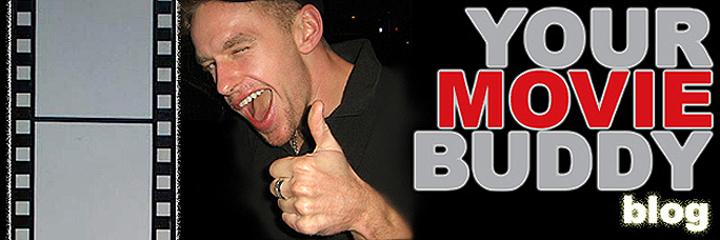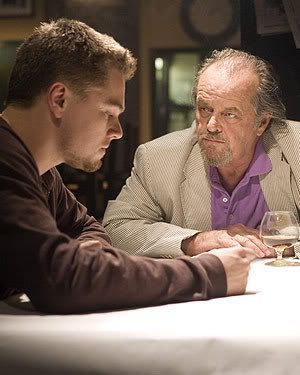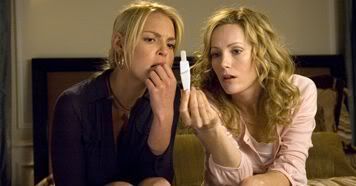 Countless other movies have given nods to Sunset at this point, including one of my all time favorites, Mike Nichols' HBO adaptation of Tony Kushner's play Angels in America. Kushner's Pulitzer Prize-winning prose is very postmodern (if I can still say that), reviving and referencing literature, politics and film that preceded the era it's responding to - the AIDS crisis of the 1980's. In addition to Sunset, Kushner either subtly or blatantly works a handful of other classic cinematic references into his story and dialogue, from Rosemary's Baby to The Wizard of Oz. Many of these are expressed in the words and actions of Angels' main character Prior Walter; like in an early scene where he informs his lover Louis that their cat has still not come home, and likens his morning experience to Shirley Booth's Oscar-winning role as Lola Delaney in Come Back, Little Sheba. While entertaining, the context of that scene meant nothing to me until I watched Sheba last month. Suddenly, it's all there: "floppy slippers, housecoat, curlers, can of Lil' Friskies," only I don't watch Prior Walter and think of Lola Delaney - I watch Lola Delaney and think of Prior Walter.
Countless other movies have given nods to Sunset at this point, including one of my all time favorites, Mike Nichols' HBO adaptation of Tony Kushner's play Angels in America. Kushner's Pulitzer Prize-winning prose is very postmodern (if I can still say that), reviving and referencing literature, politics and film that preceded the era it's responding to - the AIDS crisis of the 1980's. In addition to Sunset, Kushner either subtly or blatantly works a handful of other classic cinematic references into his story and dialogue, from Rosemary's Baby to The Wizard of Oz. Many of these are expressed in the words and actions of Angels' main character Prior Walter; like in an early scene where he informs his lover Louis that their cat has still not come home, and likens his morning experience to Shirley Booth's Oscar-winning role as Lola Delaney in Come Back, Little Sheba. While entertaining, the context of that scene meant nothing to me until I watched Sheba last month. Suddenly, it's all there: "floppy slippers, housecoat, curlers, can of Lil' Friskies," only I don't watch Prior Walter and think of Lola Delaney - I watch Lola Delaney and think of Prior Walter. Later, when Prior is confessing to Louis the details of his affliction with AIDS, he mocks Louis' insights about justice, saying "we who are about to die salute you." Imagine my surprise during my recent screening of 1950's All About Eve, when I hear Bette Davis' Margo Channing say precisely the same thing.
Later, when Prior is confessing to Louis the details of his affliction with AIDS, he mocks Louis' insights about justice, saying "we who are about to die salute you." Imagine my surprise during my recent screening of 1950's All About Eve, when I hear Bette Davis' Margo Channing say precisely the same thing. The Sunset reference takes place during one of the film's more notable sequences, wherein Prior channels Swanson in a dream. Seated before a mirror in full drag, he recites the immortal words, "I'm ready for my close-up, Mr. DeMille," which even at my first Angels viewing were culturally commonplace. But now, they register in the way Kushner intended them to...sort of. His character will always be the first variable in my version of that movie equation, even if it's chronologically incorrect.
The Sunset reference takes place during one of the film's more notable sequences, wherein Prior channels Swanson in a dream. Seated before a mirror in full drag, he recites the immortal words, "I'm ready for my close-up, Mr. DeMille," which even at my first Angels viewing were culturally commonplace. But now, they register in the way Kushner intended them to...sort of. His character will always be the first variable in my version of that movie equation, even if it's chronologically incorrect.All of this might seem painfully obvious, but it happens to me all the time. What makes Angels in America stand out is that rather than having one or two instances from my back-viewings return me to it, I've had over five. A lot of that comes from the richness of Kushner's material, as well as from the fact that all of these titles are not only part of American film iconography at large, but gay iconography in particular. Either way, seeing the originals at long last makes them and their tribute-payer that much more rewarding, finally putting a face to a name.
In closing I've provided a clip from one of Angels' quieter moments, in which Prior and Louis (in yet another dream sequence) dance to "Moon River" from the 1961 Audrey Hepburn vehicle Breakfast at Tiffany's (which I've just seen but first learned about from the 1995 Sandra Bullock vehicle The Net). Go figure.




 Thanks to this one-two summer punch, courtesy of new King of Funny Judd Apatow, 2007 saw the emergence of brilliant, hilarious comedy that needn’t resort to senseless folly or unimaginative parody to elicit laughs. Knocked Up sported the bigger heart - with growing up as much a theme as goofing off, while Superbad became the Dazed and Confused for a new generation. Comedy is perhaps the hardest genre to successfully pull off, and Apatow and co. have officially made going to the movies to laugh ‘til you cry cool again.
Thanks to this one-two summer punch, courtesy of new King of Funny Judd Apatow, 2007 saw the emergence of brilliant, hilarious comedy that needn’t resort to senseless folly or unimaginative parody to elicit laughs. Knocked Up sported the bigger heart - with growing up as much a theme as goofing off, while Superbad became the Dazed and Confused for a new generation. Comedy is perhaps the hardest genre to successfully pull off, and Apatow and co. have officially made going to the movies to laugh ‘til you cry cool again. American auteur Todd Haynes pays tribute to legendary American poet Bob Dylan by shattering all conventions of the bio-pic and presenting a picture that suggests, of all his adoring and bewildered public, Dylan himself may have known the man behind the music least of all. Six actors play the enigmatic musician in six "phases" of his life, led by Cate Blanchett who falls so comfortably into Dylan’s skin (circa his 1960's transition to electric sound) that it inspires giddy, awestruck laughter. It’s one of the finest performances of the year, and the centerpiece to one of the year’s most original movies.
American auteur Todd Haynes pays tribute to legendary American poet Bob Dylan by shattering all conventions of the bio-pic and presenting a picture that suggests, of all his adoring and bewildered public, Dylan himself may have known the man behind the music least of all. Six actors play the enigmatic musician in six "phases" of his life, led by Cate Blanchett who falls so comfortably into Dylan’s skin (circa his 1960's transition to electric sound) that it inspires giddy, awestruck laughter. It’s one of the finest performances of the year, and the centerpiece to one of the year’s most original movies.
 More of a world-creator than a filmmaker, the legendary Ridley Scott brings the same meticulously designed life he instilled in classics like Alien, Blade Runner, Gladiator and Black Hawk Down to his depiction of the ‘70's Harlem drug trade. You don’t just watch this man’s movies, you feel them through and through, and this classic cop versus crook saga has him joining the titan-like talents of Denzel Washington and Russel Crowe as real-life warriors at odds. The storytelling is first-rate, with the audience often torn with which side to root for, and the film is an engrossing rush from its start to its (albeit shaky) finish.
More of a world-creator than a filmmaker, the legendary Ridley Scott brings the same meticulously designed life he instilled in classics like Alien, Blade Runner, Gladiator and Black Hawk Down to his depiction of the ‘70's Harlem drug trade. You don’t just watch this man’s movies, you feel them through and through, and this classic cop versus crook saga has him joining the titan-like talents of Denzel Washington and Russel Crowe as real-life warriors at odds. The storytelling is first-rate, with the audience often torn with which side to root for, and the film is an engrossing rush from its start to its (albeit shaky) finish.
 Despite its overly long running time, David Fincher’s account of the infamous (and still unsolved) case of the titular killer who terrorized San Francisco in the ‘60's and ‘70's is a head-to-toe atmospheric masterpiece. Crafted in the cinematic style of the era it depicts, and told from the perspective of the journalists and policemen engaged in a decade-spanning hunt, the film plays like All the President’s Men with blood. This is indeed Fincher’s finest work to date (he being the man behind Seven, Fight Club, and Panic Room), infused with a detail as obsessive as its subject matter. Smart and uncompromising, Zodiac may just join the ranks of The Silence of the Lambs in the lineage of great serial killer movies.
Despite its overly long running time, David Fincher’s account of the infamous (and still unsolved) case of the titular killer who terrorized San Francisco in the ‘60's and ‘70's is a head-to-toe atmospheric masterpiece. Crafted in the cinematic style of the era it depicts, and told from the perspective of the journalists and policemen engaged in a decade-spanning hunt, the film plays like All the President’s Men with blood. This is indeed Fincher’s finest work to date (he being the man behind Seven, Fight Club, and Panic Room), infused with a detail as obsessive as its subject matter. Smart and uncompromising, Zodiac may just join the ranks of The Silence of the Lambs in the lineage of great serial killer movies. With this debut feature, indie fave Sarah Polley makes one of the more dignified actor-to-director transitions of recent memory, putting her in the company of Sofia Coppola as an exciting female filmmaker of her generation. Her film glows, thanks to the luminous Julie Christie (still stunning at 66) and the soft, white light of winter that spills into every frame. Gracefully adapted by Polley from the short story "The Bear Came over the Mountain" by Alice Munro, Away From Her is a testament to selfless love, which can sometimes only come from the weather-worn wisdom of age. This movie breaks your heart in all the right ways.
With this debut feature, indie fave Sarah Polley makes one of the more dignified actor-to-director transitions of recent memory, putting her in the company of Sofia Coppola as an exciting female filmmaker of her generation. Her film glows, thanks to the luminous Julie Christie (still stunning at 66) and the soft, white light of winter that spills into every frame. Gracefully adapted by Polley from the short story "The Bear Came over the Mountain" by Alice Munro, Away From Her is a testament to selfless love, which can sometimes only come from the weather-worn wisdom of age. This movie breaks your heart in all the right ways. Sweeping and utterly gorgeous, this period drama is 2007’s sweetest gift to the senses, with a first act alone to which nearly all of the year’s other films pale in comparison. Every field of cinematic artistry is engaged to its fullest and most beautiful potential, notably Dario Marianelli’s unforgettable score and Seamus McGarvey’s lush cinematography. Director Joe Wright re-teams with his Pride & Prejudice star Keira Knightley to even greater effect, but the standouts are the actresses tapped to play the girl whose wrongful actions set the plot in motion. More epic than anything else offered in the past twelve months, Atonement is a monumental achievement.
Sweeping and utterly gorgeous, this period drama is 2007’s sweetest gift to the senses, with a first act alone to which nearly all of the year’s other films pale in comparison. Every field of cinematic artistry is engaged to its fullest and most beautiful potential, notably Dario Marianelli’s unforgettable score and Seamus McGarvey’s lush cinematography. Director Joe Wright re-teams with his Pride & Prejudice star Keira Knightley to even greater effect, but the standouts are the actresses tapped to play the girl whose wrongful actions set the plot in motion. More epic than anything else offered in the past twelve months, Atonement is a monumental achievement. Structured atop the skeleton of a classic story of the evil that men do, Joel and Ethan Coen’s miraculous No Country for Old Men will likely last the ages as a veritable work of genius. The brothers capture the desolate beauty of the vistas of West Texas with immaculate composition, and fill them with riveting drama but no musical soundtrack. In its place is the click-click-boom of guns, locks, trucks and broken bones, the ominous blow of a desert wind, and the weighty dialogue and breath of well-drawn characters. No other film in 2007 inspired such an immediate need for a second viewing at its close, and no other stood so flawless a model of literary adaptation and craft.
Structured atop the skeleton of a classic story of the evil that men do, Joel and Ethan Coen’s miraculous No Country for Old Men will likely last the ages as a veritable work of genius. The brothers capture the desolate beauty of the vistas of West Texas with immaculate composition, and fill them with riveting drama but no musical soundtrack. In its place is the click-click-boom of guns, locks, trucks and broken bones, the ominous blow of a desert wind, and the weighty dialogue and breath of well-drawn characters. No other film in 2007 inspired such an immediate need for a second viewing at its close, and no other stood so flawless a model of literary adaptation and craft.




















 Atonement is being sold as a sweeping romance between the characters portrayed by Keira Knightley and James McAvoy (both fine in their roles, with the latter showing promise miles away from Narnia). That it is, indeed, but the kicker is that the story is really about the young girl who tears their love apart. The title refers to her own quest to make amends, shown eating away at her in three stages of her life. The three actresses that embody these stages give the film's standout performances, most notably newcomer Saorsie Ronan as the youngest incarnation. Her bright blue eyes and what they see (or don't see) act as a catalyst toward the road the film will follow, and in a dual-perspective approach, we get to view the action both through them and as it truly occurs. Paired with Marianelli's composition, Paul Tothill's editing makes such instances not gimmicky, but slick and vital; and in lesser scenes as simple as a character dressing for a dinner party, the cuts are as crisp as the suit being donned. This is classy filmmaking, with every aspect of cinematic production utilized to its utmost, beautiful potential.
Atonement is being sold as a sweeping romance between the characters portrayed by Keira Knightley and James McAvoy (both fine in their roles, with the latter showing promise miles away from Narnia). That it is, indeed, but the kicker is that the story is really about the young girl who tears their love apart. The title refers to her own quest to make amends, shown eating away at her in three stages of her life. The three actresses that embody these stages give the film's standout performances, most notably newcomer Saorsie Ronan as the youngest incarnation. Her bright blue eyes and what they see (or don't see) act as a catalyst toward the road the film will follow, and in a dual-perspective approach, we get to view the action both through them and as it truly occurs. Paired with Marianelli's composition, Paul Tothill's editing makes such instances not gimmicky, but slick and vital; and in lesser scenes as simple as a character dressing for a dinner party, the cuts are as crisp as the suit being donned. This is classy filmmaking, with every aspect of cinematic production utilized to its utmost, beautiful potential.
